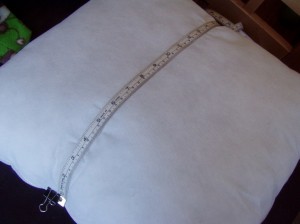 When it comes to making pillows, I have a couple of rules for myself which have stood me pretty well.
When it comes to making pillows, I have a couple of rules for myself which have stood me pretty well.
1. Measure the pillow form. I don’t care what the label on the bag says. Measure it anyway. If you are re-using a pillow form, also measure it because having people karate chop the pillow for ten years is bound to compress and shift the filling and this, believe it or not, will change the measurement. See the photo at the top. Take that measurement — that is how big you make the piece of material. NO, YOU DO NOT ADD SEAM ALLOWANCES. This is one of those ‘take it on faith things. When I have added seam allowances, I end up with a pillow cover that dwarfs the pillow insert. You want that pillow cover to be literally as tight as a drum. If you are putting a zipper into the back side (or a button flap or whatever), you need to complete that particular operation (putting in the zip, making the flap and the buttonhole and pinning it down as if it’s buttoned up or whatever), and THEN measure vertically and horizontally. If it’s greater than your original measurement, then trim down the edges until you DO get to that measurement. Again, once you sew this (and I use a half-inch seam), and put in the pillow form, it will look like Jane Mansfield at the beach, which is actually what you want. You don’t want corners that droop, or wrinkles or whatever because the pillow cover will then bunch up and wear out in odd spots. Remember: Think Jane Mansfield.
2. Fabrics. I know there are people who use stuff like dupioni and shirting to make very interesting pillow covers. I do not. That stuff will wear out in two jiffies. You want tough stuff — if you are going with clothing fabrics, think twill, sateen in a bottom weight, homespun and so on. Think heavyweight drapery fabrics. Things like dupioni might be all well and good for cushions on the couch in a room that is shut up eleven months of the year. If you are making things for a livingroom that actually is lived in (i.e., you have kids, dogs, both, or a husband who throws himself on the couch to watch the tube), then you need fabrics that will stand abuse. If you can find fabrics that come with some sort of anti-stain treatment, bully. If not, after you’ve made the pillow covers, buy yourself a can of Scotchguard(tm) and spray away (outdoors or in a very well ventilated spot like a screened in porch
3. Colors and patterns. This is the fun part of the entire process, so revel in it. Standard Operating Procedure is to look at the couch or chair. If you have a print of any sort on the major item, you can pick out solids of the print colors and feel confident that no one will end up feeling dizzy. There are, however, other ways to go. For example, you can go thematically. For example:
Nautical: The couch is covered in blue and white (or even red and white) striped ticking fabric. You can make pillows to go with that thematically (not as limited in terms of colors). Ticking is many times used as a ‘nautical’ theme foundation. So, you could make pillows out of the major color of the ticking (blue or red), small prints on the major color of the ticking, or you could throw caution to the (literally) winds and just go with pillow covers made of huge prints of ships, boats, sea birds, and nautical equipment like anchors. Get it? Got it? Good.
Another way you can go, especially if your couch or chair is a one color fabric, is to find fabrics with the same exact prints, but in two different colorways, one being a match for the color of the couch or chair. Trust me; this works. A third way to go is to find fabrics with the same print, the same colorway, but in two different sizes of the print.
And finally, you can always go the ‘world traveler’ route and throw caution to the winds and just find fabrics that are wild and crazy (but will hang together thematically, as if you bought them all in the same place — all exotic prints, or all hand stamped prints, or all flour sack prints and so on).
4 Number of Cushions. The standard thing to do on a couch is to go with even numbers of cushions. One at each end (for two), two at each end (for four). This is very balanced and classic and actually rather boring. It looks as if they all came with the couch. At that point you may as well make four all the same and be done, but that really rather ruins the fun of it. I am planning to end up with five on my couches and if they overlap, well then good for me.
5. Size of Cushions. I find cushions need to be either large enough to hit people at the shoulder blades or reach the top of the couch (if you have a rather low couch). Anything shorter than that ends up making people feel as if they are leaning back. People can always fold them in half at the sides and curl up on them, but again, anything shorter is sort of a waste of time, in terms of gaining support.
Final note: let’s say you are redoing cushions from an old couch and they are filled with feathers or a mix of feathers and down. To be blunt, after fifty years of having someone leaning on them, they are probably extremely firm and sort of lumpy. If you have sentimental attachment, then go to the internet and search on the term ‘refurbishing feather pillows” and a number of services will come up (a local dry cleaners may even be providing this service in your own area). You can send your feather pillows (and usually feather beds, down comforters and so on) to one of these places. They will remove the feathers, clean them, fluff them, add more feathers and/or down, put them into another cushion cover and send them back. Voila. Instant new pillows.

I get it, I got it, and it’s good. But does the vessel with the pessel contain the brew that is true? Because the flagon with the dragon broke and spilled it all on the old pillows, right?